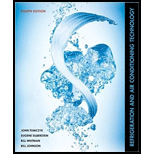
How does the compressor lubrication system differ for reciprocating and centrifugal compressors?
Difference in lubrication system of reciprocating and centrifugal compressor.
Answer to Problem 1RQ
Difference in lubrication system of reciprocating and centrifugal compressors has explained below.
Explanation of Solution
Compressor is a device which is used to compress the fluid.
Lubrication is required to reduce the heat and friction.
The centrifugal compressor consists of a separate pump, filter, cooler, oil lines and oil reservoir. The lubrication oil pumped from the reservoir to the various parts of the engine.
The reciprocating compressor consists of a small pump system which is driven by compressor crankshaft.
In reciprocating compressor, the lubricating oil pump is driven by compressor shaft whereas in centrifugal compressor, the oil pump is driven by separate motor.
Reciprocating compressor does not have separate sump for the oil, but centrifugal compressor has separate oil sump.
Want to see more full solutions like this?
Chapter 49 Solutions
Bundle: Refrigeration And Air Conditioning Technology, 8th + Lab Manual + Lms Integrated For Mindtap Hvac-r, 4 Terms (24 Months) Printed Access Card
- Solve 4.9 row a USING THE ANALYTICAL METHODarrow_forwardcutting Instructions: Do not copy the drawing. Draw In third-angle orthographic projection, and to scale 1:1, the following views of the hinge: A sectional front view on A-A A top view ⚫ A right view (Show all hidden detail) Show the cutting plane in the top view . Label the sectioned view Note: All views must comply with the SABS 0111 Code of Practice for Engineering Drawing. Galaxy A05s Assessment criteria: ⚫ Sectional front view 026 12 042 66 [30] 11 10arrow_forward1. Plot the moment (M), axial (N), and shear (S) diagrams as functions of z. a) b) F₁ = 1250 N F₁ = 600 N M₁ = 350 000 N mm F2 = 500 N 200 N a = 600 mm b=1000 mm a=750 mm b = 1000 mm d) M₁ = 350 000 N mm F₁ = 600 N F₂ =200 N a = 600 mm b = 1000 mm M₁ 175 000 Nmm F = 900 N a-250 mm b-1000 mm -250 mm. Figure 1: Schematics problem 1.arrow_forward
- Given the following cross-sections (with units in mm): b) t=2 b=25 h=25 t = 1.5 b=20 b=25 t=2 I t = 1.5 a=10 b=15 h-25 b=15 t=3 T h=25 Figure 3: Cross-sections for problem 2. 1. For each of them, calculate the position of the centroid of area with respect to the given coordinate system and report them in the table below. 2. For each of them, calculate the second moments of inertia I... and I, around their respective centroid of area and report them in the table below. Note: use the parallel axes theorem as much as possible to minimize the need to solve integrals. Centroid position x y box Moment of inertia lyy by a) b) c) d) e)arrow_forwardProblem 1: Analyze the canard-wing combination shown in Fig. 1. The canard and wing are made of the same airfoil section and have AR AR, S = 0.25, and = 0.45% 1. Develop an expression for the moment coefficient about the center of gravity in terms of the shown parameters (, and zg) and the three-dimensional aerodynamic characteristics of the used wing/canard (CL C and CM). 2. What is the range of the cg location for this configuration to be statically stable? You may simplify the problem by neglecting the upwash (downwash) effects between the lifting surfaces and the drag contribution to the moment. You may also assume small angle approximation. Figure 1: Canard-Wing Configuration.arrow_forwardProblem 2: Consider the Boeing 747 jet transport, whose layout is shown in Fig. 2 and has the following characteristics: xoa 0.25, 8 5500/2, b 195.68ft, 27.31ft, AR, 3.57, V = 0.887 Determine the wing and tail contributions to the CM-a curve. You may want to assume CM, reasonable assumptions (e.g., -0.09, 0, -4°. i=0.0°, and i = -2.0°. Make any other 0.9).arrow_forward
- Z Fy = 100 N Fx = 100 N F₂ = 500 N a = 500 mm b = 1000 mm Figure 2: Schematics for problem 3. 1. Draw the moment (M), axial (N), and shear (S) diagrams. Please note that this is a 3D problem and you will have moment (M) and shear (S) along two different axes. That means that you will have a total of 5 diagrams.arrow_forwardAn ideal gas with MW of 29 g/mol, cp = 1.044 kJ/kgK and c₁ = 0.745 kJ/kgK contained in a cylinder-piston assembly initially has a pressure of 175 kPa, a temperature of 22°C, and a volume of 0.30 m³. It is heated slowly at constant volume (process 1-2) until the pressure is doubled. It is then expanded slowly at constant pressure (process 2-3) until the volume is doubled. Draw a figure of the system and the PV diagram showing each state and the path each process takes. Determine the total work done by the system and total heat added (J) in the combined process.arrow_forwardplease explain each method used, thank youarrow_forward
- Determine the resultant loadings acting on the cross sections at points D and E of the frame.arrow_forwardA spring of stiffness factor 98 N/m is pulled through 20 cm. Find the restoring force and compute the mass which should be attached so as to stretch in spring by same amount.arrow_forwardL 2L A M B qarrow_forward
 Refrigeration and Air Conditioning Technology (Mi...Mechanical EngineeringISBN:9781305578296Author:John Tomczyk, Eugene Silberstein, Bill Whitman, Bill JohnsonPublisher:Cengage Learning
Refrigeration and Air Conditioning Technology (Mi...Mechanical EngineeringISBN:9781305578296Author:John Tomczyk, Eugene Silberstein, Bill Whitman, Bill JohnsonPublisher:Cengage Learning Welding: Principles and Applications (MindTap Cou...Mechanical EngineeringISBN:9781305494695Author:Larry JeffusPublisher:Cengage Learning
Welding: Principles and Applications (MindTap Cou...Mechanical EngineeringISBN:9781305494695Author:Larry JeffusPublisher:Cengage Learning

